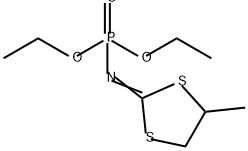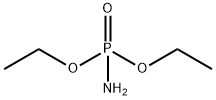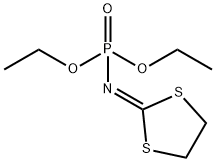MEPHOSFOLAN
- CAS NO.:950-10-7
- Empirical Formula: C8H16NO3PS2
- Molecular Weight: 269.32
- MDL number: MFCD00128050
- EINECS: 213-447-3
- SAFETY DATA SHEET (SDS)
- Update Date: 2024-12-18 14:15:32

What is MEPHOSFOLAN?
Description
Mephosfolan is a yellow to amber liquid. Molecular weight= 269.34;Boiling point=120℃ at 1.0 mmHg. Hazard Identification (based on NFPA-704 M Rating System): Health 4, Flammability 1, Reactivity 0. Moderately soluble in water.
Chemical properties
Mephosfolan is a yellow to amber liquid
The Uses of MEPHOSFOLAN
Insecticide, acaricide.
General Description
Yellow to amber liquid. Works as an insecticide and acaricide. Not registered as a pesticide in the U.S.
Reactivity Profile
When heated to decomposition, MEPHOSFOLAN emits very toxic fumes of nitrogen oxides, phosphorus oxides and sulfur oxides. Stable at neutral pH. Hydrolyzed by acid or alkali. [EPA, 1998]. Organophosphates, such as MEPHOSFOLAN, are susceptible to formation of highly toxic and flammable phosphine gas in the presence of strong reducing agents such as hydrides. Partial oxidation by oxidizing agents may result in the release of toxic phosphorus oxides.
Health Hazard
MEPHOSFOLAN is highly toxic if swallowed or absorbed through the skin.
Fire Hazard
When heated to decomposition, MEPHOSFOLAN emits very toxic fumes of nitrogen oxides, phosphorus oxides and sulfur oxides. Stable at neutral pH. Hydrolyzed by acid or alkali.
Safety Profile
Poison by ingestion and skin contact. When heated to decomposition it emits very toxic fumes of NOx, POx, and sox.
Potential Exposure
A potential danger to those involved in the production, formulation, and application of this insecticide and acaricide. Not currently registered for use in the US
First aid
If this chemical gets into the eyes, remove any contact lenses at once and irrigate immediately for at least 15 min, occasionally lifting upper and lower lids. Seek medical attention immediately. If this chemical contacts the skin, remove contaminated clothing and wash immediately with soap and water. Speed in removing material from skin is of extreme importance. Shampoo hair promptly if contaminated. Seek medical attention immediately. If this chemical has been inhaled, remove from exposure, begin rescue breathing (using universal precautions, including resuscitation mask) if breathing has stopped and CPR if heart action has stopped. Transfer promptly to a medical facility. When this chemical has been swallowed, get medical attention. Give large quantities of water and induce vomiting. Do not make an unconscious person vomit.
storage
Color Code—Blue: Health Hazard/Poison: Store in a secure poison location. Prior to working with this chemical you should be trained on its proper handling and storage. Store in tightly closed containers in a cool, wellventilated area away from strong oxidizers, strong acids.
Shipping
N3018 Organophosphorus pesticides, liquid, toxic, Hazard Class: 6.1; Labels: 6.1-Poisonous materials. UN2810 Toxic liquids, organic, n.o.s., Hazard Class: 6.1; Labels: 6.1-Poisonous materials, Technical Name Required
Incompatibilities
Incompatible with oxidizers (chlorates, nitrates, peroxides, permanganates, perchlorates, chlorine, bromine, fluorine, etc.); contact may cause fires or explosions. Keep away from alkaline materials, strong bases, strong acids, oxoacids, epoxides. Similar organic amides react with azo and diazo compounds, releasing toxic gases. Contact with reducing agents can release flammable gases. Amides are very weak bases but they can react as acids, forming salts. Mixing amides with dehydrating agents such as such as phosphorus pentoxide or thionyl chloride generates the corresponding nitrile.
Waste Disposal
In accordance with 40CFR 165 recommendations for the disposal of pesticides and pesticide containers. Must be disposed properly by following package label directions or by contacting your local or federal environmental control agency, or by contacting your regional EPA office
Properties of MEPHOSFOLAN
| Boiling point: | bp0.001 120° |
| Density | 1.539 g/cm3 (26℃) |
| refractive index | 1.5354 (589.3 nm 26℃) |
| storage temp. | APPROX 4°C
|
| pka | -4.93±0.40(Predicted) |
| Merck | 13,5880 |
| EPA Substance Registry System | Mephosfolan (950-10-7) |
Safety information for MEPHOSFOLAN
| Signal word | Danger |
| Pictogram(s) |
 Skull and Crossbones Acute Toxicity GHS06  Environment GHS09 |
| GHS Hazard Statements |
H300:Acute toxicity,oral H310:Acute toxicity,dermal H411:Hazardous to the aquatic environment, long-term hazard |
| Precautionary Statement Codes |
P264:Wash hands thoroughly after handling. P264:Wash skin thouroughly after handling. P273:Avoid release to the environment. P280:Wear protective gloves/protective clothing/eye protection/face protection. P310:Immediately call a POISON CENTER or doctor/physician. P301+P310:IF SWALLOWED: Immediately call a POISON CENTER or doctor/physician. P302+P350:IF ON SKIN: Gently wash with plenty of soap and water. |
Computed Descriptors for MEPHOSFOLAN
New Products
Tert-butyl bis(2-chloroethyl)carbamate (S)-3-Aminobutanenitrile hydrochloride N-Boc-D-alaninol N-BOC-D/L-ALANINOL N-octanoyl benzotriazole 4-Hydrazinobenzoic acid 3,4-Dibenzyloxybenzaldehyde 1,1’-CARBONYLDIIMIDAZOLE R-2-BENZYLOXY PROPIONIC ACID 1,1’-CARBONYLDI (1,2-4 TRIAZOLE) 4-HYDROXY BENZYL ALCOHOL 3-NITRO-2-METHYL ANILINE (2-Hydroxyphenyl)acetonitrile 4-Bromopyrazole 5-BROMO-2CYANO PYRIDINE 5,6-Dimethoxyindanone 5-broMo-2-chloro-N-cyclopentylpyriMidin-4-aMine 4-methoxy-3,5-dinitropyridine 2-(Cyanocyclohexyl)acetic acid 2-aminopropyl benzoate hydrochloride 1-(4-(aminomethyl)benzyl)urea hydrochloride tert-butyl 4- (ureidomethyl)benzylcarbamate diethyl 2-(2-((tertbutoxycarbonyl)amino) ethyl)malonate Ethyl-2-chloro((4-methoxyphenyl)hydrazono)acetateRelated products of tetrahydrofuran








You may like
-
 Mephosfolan CAS 950-10-7View Details
Mephosfolan CAS 950-10-7View Details
950-10-7 -
 55441-95-7 99%View Details
55441-95-7 99%View Details
55441-95-7 -
 N-Vinylformamide 99%View Details
N-Vinylformamide 99%View Details
13162-05-5 -
 Chloro Uracil 1820-81-1 99%View Details
Chloro Uracil 1820-81-1 99%View Details
1820-81-1 -
 207557-35-5 99%View Details
207557-35-5 99%View Details
207557-35-5 -
 2-ethyl-6-methyl-3-hydroxypyridine succinate 99%View Details
2-ethyl-6-methyl-3-hydroxypyridine succinate 99%View Details
127464-43-1 -
 2-ETHYLPYRIDINE 100-71-0 99%View Details
2-ETHYLPYRIDINE 100-71-0 99%View Details
100-71-0 -
 181228-33-1 (S)-Methyl 3-amino-2-((tert-butoxycarbonyl)amino)propanote Hydrochloride (DAP-OMe. HCl) 99%View Details
181228-33-1 (S)-Methyl 3-amino-2-((tert-butoxycarbonyl)amino)propanote Hydrochloride (DAP-OMe. HCl) 99%View Details
181228-33-1